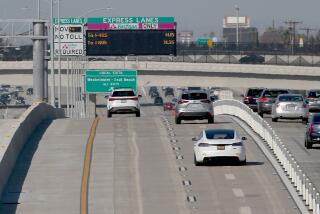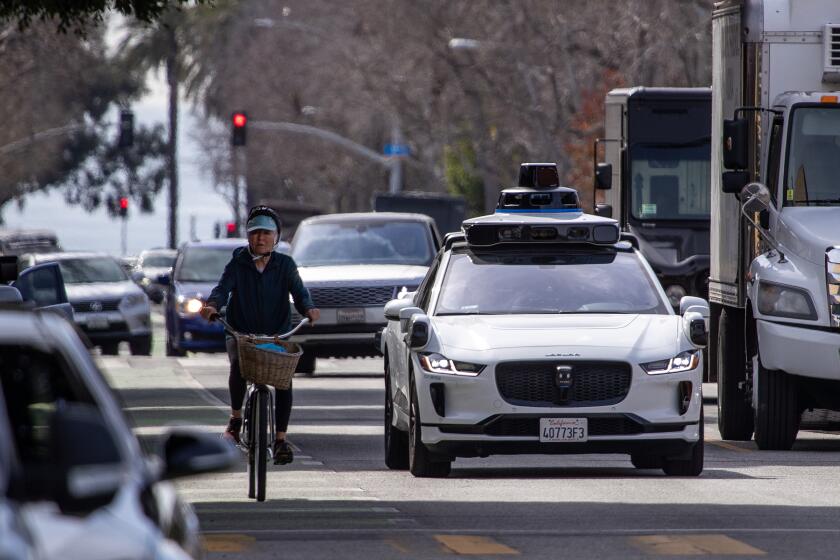As Toll Roads Gain Toehold in Southland, Critics Fear ‘Highway Robbery’ : CITY SMART: How to thrive in the urban environment of Southern California
- Share via
In Orange County, work is nearing completion on the nation’s first privately owned and operated toll road in 50 years.
In San Diego County, officials will soon open a “Lexus lane,” so called because solo drivers--mostly luxury car owners, critics say--can buy their way into less-congested car-pool lanes.
And in Los Angeles? The unthinkable may not be far off: a toll road in Freeway City.
Toll roads could be used to pay for building upper decks on existing freeways. Or single-occupant vehicles may be permitted, for a fee, to enter the soon-to-open elevated car-pool lane on the Harbor Freeway or car-pool lanes on other freeways.
Some may object to Cadillacs being able to zoom past Chevys because of their owners’ economic status.
But everyone can benefit from toll roads, according to the Reason Foundation, a pro-privatization think tank in Santa Monica. It contends that every car on a toll road is one less car congesting the existing freeway.
Still, critics object to relegating lower-income drivers to the lower level--literally and figuratively.
State Senate President Pro Tem Bill Lockyer called toll roads “un-Californian” and “a form of highway robbery.”
But Gerald Pfeffer, managing director of the California Private Transportation Co., said Los Angeles could use tolls to finance hundreds of miles of planned car-pool lanes that otherwise might not get built because of lack of tax dollars.
“Some people have called these Robin Hood lanes because people in Lexuses are paying for a facility that is used by Joe Sixpack in a car pool,” said Pfeffer, whose firm is building a toll road--two lanes in each direction--on the median of the Riverside Freeway in Orange County.
The toll will be 25 cents at most times, but at rush hour, will rise to $2.50 or more for the 10-mile trip.
There will be no tollbooths. A windshield tag will be scanned to debit the driver’s account. Vehicles with three or more people will travel free. Three other tollway projects are also under way in Orange County.
Geoffrey S. Yarema, an attorney with Nossaman, Guthner, Knox & Elliott and an expert in public works and finance, has proposed opening--for a fee--the 10-mile bus and car-pool elevated roadway nearing completion along the Harbor Freeway.
“Anybody who thinks that a [toll lane] project is discriminatory and only for the Lexuses and Mercedeses of the world isn’t a single working mother who has to pay a $5 penalty for every five minutes she’s late picking up her child” from day care, he said.
Tolls could be used by the MTA to improve bus service or keep down fares.
“So many people, when they think about toll roads, think about the New Jersey Turnpike and these old toll facilities which are very user-unfriendly,” Yarema said. When the state-of-the-art Orange County toll road opens, “you’re going to see how 21st-Century technology has created a very user-friendly, very exciting new mobility option.”
The toll road is one of scores of ideas likely to be studied by a Southern California task force recently formed to come up with ideas to reduce smog and traffic congestion in the 21st Century. Another: “congestion pricing,” which includes charging more to use the freeway during rush hour.
*
The REACH task force (for Reduce Emissions and Congestion on Highways) received an $880,000 federal grant and will, among other things, conduct focus groups and public opinion surveys on a wide range of transit measures.
By 2010, average rush-hour freeway speeds are projected to slow to 11 m.p.h., down from today’s 31 m.p.h., according to a task force report.
Transit experts will be closely watching the toll road experiments in Orange and San Diego counties.
In San Diego, officials plan to charge solo drivers a minimum $2.60 to enter the car-pool lane along an eight-mile stretch of Interstate 15.
John Duve, project manager for advanced transportation systems for the San Diego County Assn. of Governments, said he has received calls from husbands and wives wanting to buy a month’s use of the toll road as a gift for their spouses.
The toll will be posted at the entrance, along with the estimated time savings of using the toll lane. The price will rise as congestion increases to keep the lane moving at 50 m.p.h.
The San Diego experiment is designed to increase car-pooling. “We think that once people try it and enjoy the [average 20-minute time] savings, that in the American way, they’ll try to figure out a way to avoid the cost. One way to do that is to get another person in their car.”
State Sen. Tom Hayden (D-Santa Monica) said he plans to introduce legislation to block new toll roads and thwart all such efforts at “behavior modification.”
Assemblyman Richard Katz (D-Sylmar), chairman of the Assembly Transportation Committee, is skeptical of Los Angeles ever getting a toll road.
“If you allow people to buy into the [high-occupancy-vehicle] lane, you defeat the purpose of having HOV lanes,” which is to reduce smog, he said.
Logistics also are a problem in urban L.A. “With an on-ramp and off-ramp every quarter-mile or half-mile, it makes it virtually impossible unless you put a toll collector at each metering ramp,” he said.
A bigger problem with opening an elevated toll road, said Katz, is that “you’ll have a hard time convincing people to use it because of earthquakes.”
More to Read
Sign up for Essential California
The most important California stories and recommendations in your inbox every morning.
You may occasionally receive promotional content from the Los Angeles Times.














